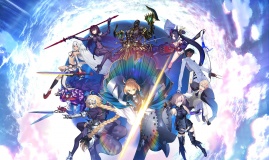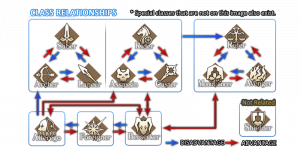Fate/Grand Order
| Genre | Tactical role-playing game |
| Gamming Style | Mobile |
| Platform | Android, iOS |
| Release Date | 2015-Present |
| Developer | Delightworks |
| Publisher | Aniplex |
| Website | Fate/Grand Order Official USA Website |
Fate/Grand Order is a mobile RPG game developed by Delightworks and published by Aniplex on July 30, 2015 for Android platform in Japan. An iOS release version followed on August 12, 2015. Over the years, the game was released across various countries including the United States, Canada, China, and Korea. The game is free-to-play and includes the gacha mechanic where players can spend real money to obtain additional in-game items through chances. There are also manga, anime and movie adaptations from the game’s main story.
The game uses 2D visuals and texts to tell a story of where the main character, Ritsuka Fujimaru, travels back to various timelines for humanity’s survival. Players of the game will role play as the “Master” and control “Servants” to fight in battles through different types of Command Cards. The Servants will take turns with the enemies to attack until HP reaches 0. These Servants are often based on famous historical or legendary figures and use the same name as those figures.
Ethical issues of the game rose with the gacha system and its low percent chance of obtaining 5 stars Servants without a pity system. The portrayal of Servants that relate to historical characters from other cultures along with the time setting of in-game events also causes discussions on Twitter and censorship of characters’ visuals in China.
Contents
Gameplay
Combat
In Fate/Grand Order, the main gameplay performs through turn-based combat. Before a battle, the player chooses a party consisting of 6 Servants, with one of the slots being a support unit from a friend. 3 of the party members will be active for battle while the other 3 will be in reserve. In the preparation phase of battle, players can check on the Servant status and tap to activate Servant Active Skills, Command Spells, or Master Skills. [1]
Afterwards, the player clicks on the Attack button to obtain 5 randomly distributed Command Cards, then choose 3 out of the 5 cards in a specific order. The Command Cards have 3 types, which are Arts, Buster, and Quick. Each card corresponds to one of the active Servants, who will be performing the action of the card. There will be a total of 15 cards in the pool, with each of the 3 Servants providing 5 cards. First card that the player chooses will provide a bonus to other cards based on its type. When 3 cards of the same type are picked, there are additional effects known as Arts Chain, Quick Chain, or Buster Chain depending on the card type. If 3 cards correspond to the same Servant, then it triggers another effect called Brave Chain. A battle animation will play once the player decides on the cards. Aside from the 3 standard Command Cards, the player can also charge up Noble Phantasm, an ultimate ability. Once the Noble Phantasm fully charges, it will show up as an additional card to choose aside from the 5 random cards. [2]
Servants
Servants are unique characters in-game for the player to control. Every Servant has a Class, Noble Phantasm, and various skills. There are 7 main classes (Saber, Archer, Lancer, Rider, Caster, Assassin, and Berserker) as well as 7 extra classes (Ruler, Avenger, Moon Cancer, Alter Ego, Foreigner, and Pretender). Classes can have advantages and disadvantages when going against certain other classes. Players will be able to upgrade or Ascend their Servants to gain new skills. Ascending the Servants will also change their art and battle spirit. Servants’ Noble Phantasm is also upgradable using duplicates of the same Servant up to a max level of 5. The methods of obtaining new Servants include in-game events and rolling the gacha system, which are often time limited. [3]
Plot
Ethical Issues
Racism
In February of 2019, the North American version of Fate/Grand Order released a visual redesign of a character named Emiya(Alter) that looked different from other regions. In the story, the character’s skin turns dark as a result of overusing magic. For the western version, this darkened skin has been lightened to avoid associating with racist depiction of black face. A related line where another character Tamamo-no-Mae calls Emiya(Alter) as Detroit Emiya was also changed to Edgy Emiya. Fans react to this change differently on Twitter. Some view positively to the change while others believe this ignores the backstory and intention of the original artist. [4]
Gacha
To acquire additional Servants and Craft Essences, the players need to spend Saint Quartz on the Banner, the gacha system in-game, for summoning. Saint Quartz are available through in-game purchases through real money or earned in-game. The summoning rate of the 5 stars Servants is 1% and the rates for 5 stars Craft Essences is 4%. From its initial release in July of 2015 to January of 2022, the method to summon a desired Servant depends on the luck of a player. According to The Wall Street Journal, a 31-years-old man named Diego has spent over $70,000 to obtain rare Servants in the game. [5]
Similar gacha mobile games such as Arknights, Genshin Impact, and Guardian Tales have a pity system that guarantees the rewards once a specific amount of money is spent. In January of 2022, the Japan version of the Fate/Grand Order introduced a new pity system, which guarantees to summon a SSR(5 stars Servant) on the 330 rolls. [6] This pity system is only valid before the player pulls the first SSR that corresponds to the specific gacha pool. For players wishing to obtain duplicates of the same SSR to upgrade the Servant’s Noble Phantasm, the pity system won’t work. Also, the pity counter on the number of rolls doesn’t carry over to the next Banner, meaning the counter resets to 0 when the gacha pool changes.
Controversy in Korea
On June 6 of 2018, Fate/Grand Order announced a new event called "Gudaguda Teito Seihai Kitan" (Gudaguda Imperial Capital Holy Grail Strange Story). This in-game event tells a story of the Japanese Imperial Army attempting to win a frictional war that takes place in 1945. 1945 is the same year as the end of World War II and the end of Japan’s dominance in Asia, which angers South Korea’s game communities. South Korean players view the event as a way to glorify Japan’s army in World War II. Another reason for the controversy is because the date of the announcement, June 6, is also the Memorial Day of South Korea. On Twitter, fans use the hashtag “#FGODirectorsShouldApologize” to express their upset, hoping the staff will give an apology. [7]
Censorship in China
China considers many of the arts of the Servant in Fate/Grand Order as overly sexualized, resulting in multiple edits on various characters’ appearance in 2017 such as the Servants Boudica, Shuten Dōji, and Mata Hari. [8] [9] Edits include cropping of portraits, covering more body parts, and removing the entire illustration. In September of 2021, the Chinese server of the game received another censorship.
References
- ↑ GrandOrderWiki Gameplay[1]
- ↑ GrandOrderWiki Command Cards[2]
- ↑ Fate/Grand Order Wiki Servants[3]
- ↑ Bounding Into Comics, Fate/Grand Order Edits Emiya Alter Design for North American Release[4] 9 January 2019.
- ↑ The Wall Street Journal, Meet the Man Who’s Spent $70,000 Playing a Mobile Game[5]
- ↑ Siliconera, Fate/Grand Order Implements a Pity System in Gacha[6]
- ↑ AnimeNewsNetwork, Fate/Grand Order Game's New Event Set in 1945 Stirs Controversy[7]
- ↑ Kotaku Australia, China Keeps Censoring Fate/Grand Order Character Art[8]
- ↑ Crunchyroll, China Takes Mata Hari and Boudica Down a Notch for "Fate/Grand Order"[9]



